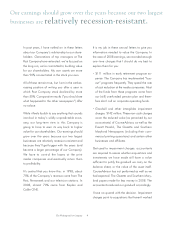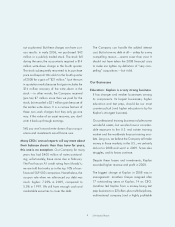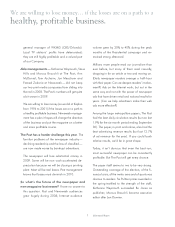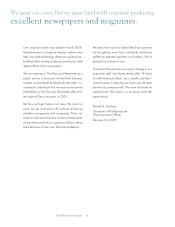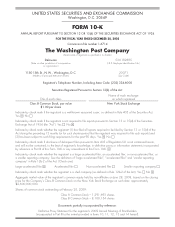Washington Post 2008 Annual Report Download - page 16
Download and view the complete annual report
Please find page 16 of the 2008 Washington Post annual report below. You can navigate through the pages in the report by either clicking on the pages listed below, or by using the keyword search tool below to find specific information within the annual report.to over 69,000 students through distance-learning programs. Additionally, three Kaplan Business School Centers are now
fully accredited in Australia (Sydney, Melbourne and Adelaide), with the first intake planned for March 2009, offering
foundation and master’s degree programs.
Title IV Federal Student Financial Aid Programs
Funds provided under the student financial aid programs that have been created under Title IV of the Federal Higher
Education Act of 1965, as amended, historically have been responsible for a majority of the net revenues of Kaplan
Higher Education. During 2008, funds received under the Title IV programs accounted for approximately $904 million,
or approximately 71%, of total Kaplan Higher Education revenues, and 39% of Kaplan, Inc. revenues. The Company
estimates that funds received from students borrowing under private loan programs comprised approximately an
additional 5% of its higher education revenues. In late 2008, as the private loan programs deteriorated, Kaplan Higher
Education began providing loans directly to Kaplan students under an institutional loan program. Direct student payments
and funds received under various state and agency grant programs accounted for most of the remainder of 2008 higher
education revenues. The significant role of Title IV funding in the operations of Kaplan Higher Education is expected to
continue.
Title IV programs encompass various forms of student loans, with the funds being provided either by the federal
government itself or by private financial institutions with a federal guaranty protecting the institutions against the risk of
default. In some cases, the federal government pays part of the interest expense. Other Title IV programs offer
non-repayable grants. Subsidized loans and grants are only available to students who can demonstrate financial need.
During 2008, approximately 75% of the approximately $904 million of Title IV funds received by Kaplan Higher
Education came from student loans, and approximately 25% of such funds came from grants.
To maintain Title IV eligibility, a school must comply with extensive statutory and regulatory requirements relating to its
financial aid management, educational programs, financial strength, facilities, recruiting practices and various other
matters. Among other things, the school must be licensed or otherwise authorized to offer its educational programs by the
appropriate governmental body in the state or states in which it is physically located, be accredited by an accrediting
agency recognized by the U.S. Department of Education (the “Department of Education”) and be certified to participate in
the Title IV programs by the Department of Education. Schools are required periodically to apply for renewal of their
authorization, accreditation or certification with the applicable state governmental bodies, accrediting agencies and the
Department of Education. In accordance with Department of Education regulations, a number of the schools in Kaplan’s
Higher Education Division are combined into groups of two or more schools for the purpose of determining compliance
with certain Title IV requirements. Including schools that are not combined with other schools for that purpose, the Higher
Education Division has 34 Title IV reporting units.
A school may lose its eligibility to participate in Title IV programs if student defaults on the repayment of Title IV loans
exceed specified default rates (referred to as “cohort default rates”). The Department of Education calculates a cohort
default rate for each one of Kaplan’s 34 Title IV reporting units. The schools in a Title IV reporting unit whose cohort
default rate exceeds 40% for any single year may lose their eligibility to participate in the Federal Family Education Loan
(“FFEL”) and Direct Loan programs for at least two fiscal years, except in the event of a successful adjustment or appeal.
The schools in a Title IV reporting unit whose cohort default rate equals or exceeds 25% for three consecutive years may
lose their Title IV eligibility to participate in FFEL, Direct Loan and Federal Pell Grant programs for at least two fiscal years,
except in the event of a successful adjustment or appeal.
The enactment in August 2008 of the Higher Education Opportunity Act (which reauthorized the Federal Higher
Education Act) changed the cohort default rate calculation for future years. Under the revised law, the period of time for
which student defaults are tracked and included in the cohort default rate calculation is extended by a year, which is
expected to increase the cohort default rates for most institutions. That change will be effective with the calculation of
institutions’ cohort default rates for the federal fiscal year ending September 30, 2009; those rates are expected to be
calculated and issued by the Department of Education in 2012. The Department of Education will not impose sanctions
based on rates calculated under this new methodology until three consecutive years of rates have been calculated, which
is expected to occur in 2014. Until that time, the Department of Education will continue to calculate rates under the old
method, as well and impose sanctions based on those rates. The revised law also increases the threshold for ending an
institution’s participation in the Title IV programs from 25% to 30%, effective in fiscal year 2012.
Prior to the enactment of the Higher Education Opportunity Act, any for-profit post-secondary institution (a category that
includes all of the schools in Kaplan’s Higher Education Division) would lose its Title IV eligibility for at least one year if
more than 90% of the institution’s receipts for any fiscal year were derived from Title IV programs, as calculated on a cash
basis in accordance with the Federal Higher Education Act and applicable Department of Education regulations. Under
4THE WASHINGTON POST COMPANY


